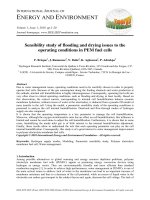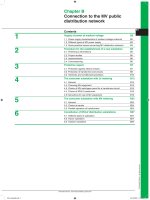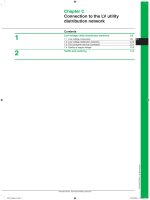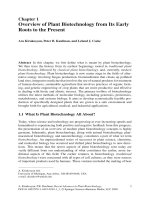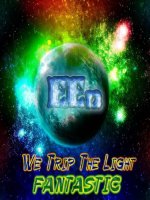maxfield, c. (2002). bebop to the boolean boogie (2nd ed.)
Bạn đang xem bản rút gọn của tài liệu. Xem và tải ngay bản đầy đủ của tài liệu tại đây (26.39 MB, 506 trang )
I
1,
konics
auide
a
CD-I
I
contoins eBook version with full tex orch
PLUS
BONUS
CHAPTER
An
Illustrated
History
or
rrectronics
anu compi
BEBOP
TO
THE
BEBOP
TO
THE
An
unconwentional guide to electronics
fundamentals, components,
and
processes
by
Clive (call me “Max”) Maxfield
Foreword by Pete Waddell,
Publisher
of
Printed Circuit
Design
N
e
w
n
es
Amsterdam Boston Heidelberg London New York
Oxford
Paris San Diego San Francisco Singapore Sydney Tokyo
Newnes is an imprint of Elsevier Science.
Copyright
0
2003,
Elsevier Science
(USA).
All
rights reserved.
No part of this book may be reproduced, stored in a retrieval system,
or transmitted in any form or
by
any means, electronic, mechanical,
photocopying, recording, or otherwise, without
the
prior written
permission of the publisher.
Recognizing the importance
of
preserving what has been written,
Elsevier Science prints its books on acid-free paper whenever possible.
Library
of
Congress Cataloging-in-Publication Data
Maxfield, Clive,
1957-
Bebop to the boolean boogie
:
an unconventional guide to
electronics fundamentals, components, and processes
/
by
Clive
(call me “Max”) Maxfield
;
foreword by Pete Waddell 2nd ed.
p. cm
Includes bibliographical references and index.
ISBN
0-7506-7543-8
(alk. paper)
1.
Digital electronics-Popular works.
I.
Title.
TK7868.D5
M323
2002
62
1.381-dc21
2002038930
British Library Cataloguing-in-Publication Data
A
catalogue record for this book is available from the British Library.
The publisher offers special discounts on bulk orders of this book. For
information, please contact:
Manager of Special Sales
Elsevier Science
200 Wheeler Road
Burlington,
MA
01803
Tel: 781-313-4700
Fax:
781-3
13-4882
For information on all Newnes publications available, contact our
World Wide Web home page at:
Printed in the United States
of
America
10
9
8
7
6
5
4
3
2
Foreword
My
first exposure
to
the unique writing style of Clive (call me “Max”)
Maxfield was a magazine article that he co-wrote with an associate. The
article was technically brilliant (he paid me to say that) and very infor-
mative, but it was the short biography at the end of the piece that
I
enjoyed
the most.
I
say enjoyed the most because, as you will soon learn, Max does
not necessarily follow the herd
or
dance to the same drummer as the masses.
Trade journals have a reputation for being informative and educational but
also as
dry
as
West Texas real estate.
Anyway, Max’s personally submitted biography not only included a
message from his mom, but also made mention of the fact that he (Max)
is
taller than his co-author, who just happened
to
be his boss at the time.
Now
to
some people this may seem irrelevant, but to our readers (and Max’s
boss), these kind
of
things-trivial as they may seem
to
the uninitiated-
are what helps
us
to maintain our off-grid sense of the world. Max has
become, for better or worse, a part of that alternate life experience.
So
now it’s
a
couple of years later, and Max has asked me to write a
few words
by
way of introduction. Personally,
I
think that the title of this
tome alone (hmmm, a movie?) should provide some input as to what
YOU
can expect, But, for those who require a bit more: be forewarned, dear
reader,
YOU
will probably learn far more than you could hope
to
expect from
Bebop
to
the
Boolean
Boogie,
just because
of
the unique approach Max has
to
technical material. The author will guide you from the basics through
a minefield of potentially boring theoretical mish-mash, to a Nirvana
of
understanding. You will not suffer that fate familiar to every reader:
was trying to
say.
For a limey, Max shoots amazingly well and from the hip,
but
in
a way that will keep you interested and amused.
If
you are not
vigilant, you may not only learn something, but you may even enjoy the
process. The only further advice
I
can give is to “expect the unexpected.”
ing paragraphs over and over wondering what in the world the author
-
PETE
WADDELL,
Publisher,
Printed Circuit
Design
Literary genius
(so
says his mom), and taller than Max
by
%”
Contents
Not a Lot
40
Functions versus Gates
43
Chapter
1
Analog versus Digital
1
Chapter
2
Atoms. Molecules. and
Crystals
7
Chapter
3
Conductors and Insulators;
Voltage. Current.
Resistance. Capacitance.
and Inductance
12
Voltage. Current and Resistance
13
Capacitance
16
Inductance
19
Unit Qualifiers
22
Chapter
4
Semiconductors: Diodes
and Transistors
24
The Electromechanical Relay
24
The First Vacuum Tubes
25
Semiconductors
26
Semiconductor Diodes
28
Bipolar Junction Transistors
29
Metal-Oxide Semiconductor
Field-Effect Transistors
30
The Transistor as a Switch
32
Gallium Arsenide
Semiconductors
33
Light-Emitting Diodes
33
Chapter
5
Primitive Logic
Functions
36
BUF
and
NOT
Functions
38
AND.
OR.
and
XOR
Functions
39
NAND.
NOR.
and
XNOR
Functions
40
Chapter
6
Using Transistors to
Build Primitive Logic
Functions
44
NOT
and
BUF
Gates
44
NAND
and
AND
Gates
46
NOR
and
OR
Gates
48
XNOR
and
XOR
Gates
49
Pass-transistor Logic
51
Chapter
7
Alternative Numbering
Systems
52
Decimal (Base-10)
52
Duo-Decimal (Base-12)
54
Sexagesimal (Base-60)
55
The Concepts of Zero and
Negative Numbers
56
Vigesimal (Base-20)
57
Quinary (Base Five)
58
Binary (Base-2)
59
Octal (Base-8) and Hexadecimal
(Base-16)
61
Representing Numbers Using
Powers 63
Tertiary Logic
66
Chapter
8
Binary Arithmetic
67
Unsigned Binary Numbers
67
Binary Addition
68
Binary Subtraction
70
Signed Binary Numbers
75
Binary Multiplication
78
viii Bebop to the Boolean Boogie
Chapter
9
Boolean Algebra
80
Combining a Single Variable
with Logic
0
or Logic
1
83
The Idempotent Rules
84
The Complementary Rules
84
The Involution Rule
85
The Commutative Rules
85
The Associative Rules
86
Precedence of Operators
87
The First Distributive Rule
88
The Second Distributive Rule
89
The Simplification Rules
90
DeMorgan Transformations
92
Minterms and Maxterms
94
Sum-of-Products and
Product-of-Sums
94
Canonical Forms
96
Chapter
10
Karnaugh Maps
97
Minimization Using Karnaugh
Maps
98
Grouping Minterms
100
Incompletely Specified
Functions
102
Populating Maps Using
Os
versus
1s
103
RS
Latches
112
D-Type Flip-flops
120
D-Type Latches
118
JK
and
T
Flip-flops
123
Shift Registers
124
Counters
126
Setup and Hold Times
128
Brick
by
Brick
130
Chapter
12
State Diagrams.
State Tables. and
State Machines
131
State Diagrams
132
State Tables
134
State Machines
134
State Assignment
136
Don’t Care States. Unused States.
and Latch-Up Conditions
138
Chapter
13
Analog-to-Digital and
Digital-to-Analog
140
Analog-to-Digital
140
Digital-to-Analog
142
Chapter
11
Using Primitive Logic
Functions to Build More
Complex Functions
105
Scalar versus Vector Notation
105
Equality Comparators
106
Multiplexers
107
Decoders
109
Tri-State Functions
1
10
Combinational versus Sequential
Functions
1
I2
_I
Chapter
14
lntegrated Circuits
(ICs)
143
An
Overview of the Fabrication
Process
143
A
More Detailed Look at the
Fabrication Process
145
The Packaging Process
151
Integrated Circuits versus
Discrete Components
155
Different Types of
ICs
155
Technolow Considerations
156
Contents
ix
Chapter
I5
Memory ICs
162
Architectures
165
Increasing Width and Depth
170
Alternative Technologies
I
72
Underlying RPLM and ROM
Chapter
I6
Programmable ICs
178
Fusible-link Technologies
1 79
Antifuse
Technologies
179
Special PLD Notation
I81
Generic PLD Structures
I82
Programmable Logic Arrays
(PLAs)
183
Programmable
Array
Logic
(PAL)
184
Programmable Read-only
Memories (PROMS)
185
Additional Programmable
Options
186
Programming PLDs
189
Reprogrammable PLDs
191
Complex PLDs (CPLDs)
195
Arrays (FPGAs)
196
Why Use Programmable ICs?
199
Field-Programmable Gate
Chapter
I
7
Application-Specific
Integrated Circuits
(ASlCs)
201
Gate
Array
Devices
202
Standard Cell Devices
206
Full
Custom
Devices
208
Input/Output Cells and Pads
209
Who
Are
All
the
Players?
21
0
e
ASIC
Design Flow
21
3
ASIC.
ASSP.
and
COT
21
8
Summary
2 19
Chapter
18
Circuit Boards
221
The
First Circuit Boards
221
PCBs and PWBs
222
Subtractive Processes
222
Additive Processes
225
Single-sided Boards
226
Lead Through-Hole (LTH)
229
Surface Mount 'Technology
(SMT)
231
Double-sided Boards
233
Holes
versus
Vias
235
Multilayer Boards
237
Microvia, HID, and Build-up
Technologies
241
Discrete Wire Technology
243
Backplanes and Motherboards
252
Conductive Ink Technology
253
Chip-On-Board (COB)
255
Flexible Printed
Circuits
(FPCs) 256
Chapter
19
Hybrids
258
Hybrid Substrates
258
The
Thick-Film Process
260
The
Thin-Film Process
265
The
Assembly Precess
268
The
Packaging Process
273
Chapter
20
Multichip Modules
(MCMs)
275
Categorization
by Substrate
276
Why Use Multichip Modules?
277
Cofired
Ceramics
279
Low-fired Cofired
Ceramics
282
Assembly and Packaging
283
Equivalent Integrated
Circuits
287
The
Mind Boggles
288
x
Bebop to the Boolean Boogie
Chapter
2
7
Alternative and Future
Technologies
290
Reconfigurable Hardware and
Interconnect
290
Adaptive Computing Machines
(
ACMs)
300
Three-Dimensional Molded
Interconnect
303
Optical Interconnect
305
Optical Memories
3
15
Protein Switches and Memories
.
3
16
Electromagnetic Transistor
Fabrication
320
Heterojunction Transistors
320
Buckyballs and Nanotubes
323
Diamond Substrates
325
Chip-On-Chip
(COC)
328
Conductive Adhesives
3
29
Superconductors
33
1
Nanotechnology
333
Again, the Mind Boggles
339
Summary
340
Appendix A
Appendix
B
Assertion-Level
Logic
34
1
Positive Logic versus
Negative Logic
345
Physical to Abstract Mapping
Physical to Abstract Mapping
Physical
to
Intermediate to
(NMOS Logic)
346
(PMOS
Logic)
348
Abstract Mapping
349
Appendix C Reed-Muller Logic
353
Appendix
E
A Reed-Muller
Extraction Utility
362
How to Become Famous
377
Appendix
F
Linear Feedback Shift
Registers (LFSRs)
381
Many-to-One Implementations
381
More Taps Than You Know
What to
Do
With
384
One-to-Many Implementations
385
Seeding an
LFSR
386
FIFO
Applications
386
Modifying
LFSRs
to Sequence
2n
Values
389
Accessing the Previous Value
390
Encryption and Decryption
Applications
391
Cyclic Redundancy Check
Applications
391
Data Compression Applications
.
393
Built-in Self-Test Applications
395
Pseudo-Random Number
Applications
397
Last But Not Least
400
Appendix
G
Pass- Transistor
Logic
401
Appendix
H
No-Holds-Barred
Seafood Gumbo
405
Abbreviations and Acronyms
409
Glossary
412
Index
446
Bonus Chapter: An Illustrated History
of Electronics and
Computing
On
CD-ROM
Appendix
D
Gray Codes
358
This
book
is
dedicated to my Auntie Barbara,
whose assiduous scrubbing in my younger years
has
left
me
the
proud owner
of
the
cleanest pair
of knees in
the
known uniwerse!
About
this
Book
oolean
Boogie,
whic
This outrageously interesting book has two namesakes, Bebop, a jazz style
known for its fast tempos and agitated rhythms, and Boolean algebra, a branch
of mathematics that is the mainstay of the electronics designer’s tool chest.
Bebop
to
the
Boolean
Boogie
meets the expectations set
by
both, because
it
leaps
from topic to topic with the agility of a mountain goat, and
it
will
become
your key reference guide to understanding the weird and wonderful world of
electronics.
Bebop to
the
Boolean Boogie
provides a wide-ranging but comprehensive
introduction to the electronics arena, roaming through the fundamental
concepts, and rampaging through electronic components and the processes
used to create them.
As
a bonus, nuggets of trivia are included with which
you can amaze your family and friends; for example, Greenland Eskimos have
a base twenty number system because they count using both fingers and toes.
Section
I
:
Fundamental Concepts
starts
by
considering the differences
between analog and digital views
of
the world. We then proceed rapidly
through atomic theory and semiconductor switches to primitive logic functions
and their electronic implementations. The concepts of alternative numbering
systems are presented, along with binary arithmetic, Boolean algebra, and
Karnaugh map representations. Finally, the construction of more complex
logical functions is considered along with their applications.
Section
2:
Components and Processes
is where we consider the components
from which electronic systems are formed and the processes required to
construct them. The construction of integrated circuits is examined
in
some
detail, followed
by
introductions to memory devices, programmable devices,
and application-specific devices. The discussion continues with hybrids,
printed circuit boards, and multichip modules. We close with an overview of
some alternative and future technologies along with a history of where every-
thing came from. Also, there’s a bonus chapter (Chapter
22),
An
Illustrated
History
of
Electronics and Computing,
on the
CD-ROM
accompanying this
book, that will answer questions you didn’t even think to ask!
This book is of particular interest to electronics students. Additionally,
by
clarifying the techno-speech used
by
engineers, the book is of value to anyone
who is interested in understanding more about electronics but lacks a strong
technical background.
Except where such interpretation is inconsistent with the context, the
singular shall be deemed to include the plural, the masculine shall be deemed
to include the feminine, and the spelling (and the punctuation) shall be
deemed to be correct!
About the Author
Clive “Max” Maxfield
is
6’
1”
tall, outrageously handsome, English and
proud
of
it.
In
addition to being a hero, trendsetter, and leader of fashion,
he
is
widely regarded as an expert
in
all aspects
of
electronics (at least
by
his
mother).
After receiving his BSc.
in
Control Engineering in
1980
from Sheffield
Polytechnic (now Sheffield Hallam University), England, Max began
his
career as a designer
of
central processing units for mainframe computers.
To
cut
a
long story short, Max now finds himself President of TechBites
Interactive (www.techbites.com).
A
marketing consultancy, TechBites
specializes
in
communicating the value of technical products and services to
non-technical audiences through such mediums as websites, advertising,
technical documents, brochures, collaterals, and multimedia.
In
his
spare time (Ha!), Max is co-editor and co-publisher of the
web-delivered electronics and computing hobbyist magazine
EPE
Online
(www.epemag,com) and a contributing editor to www.eedesign.com.
In
addition to numerous technical articles and papers appearing
in
magazines
and at conferences around the world, Max
is
also the author of
Designus
Maximus Unleashed (Banned in
Alabama)
and co-author of
Bebop
BYTES
(An
Unconventional Guide to Computers).
to as an
“industry notable”
and a
“semiconductor design expert”
by
someone
famous who wasn’t prompted, coerced, or remunerated in any way!
On
the off-chance that you’re still not impressed, Max was once referred
Acknowledgments
Special thanks for technical advice
go
to Alvin Brown, Alon Kfir,
Don Kuk, and Preston Jett, the closest thing to living encyclopedic
reference manuals one could hope
to
meet. (The reason that the text
contains
so
few bibliographic references is due to the fact that
I
never
had
to
look anything up-I simply asked the relevant expert for the
definitive answer.)
I
would also like to thank Dave Thompson from Mentor Graphics,
Tamara Snowden and Robert Bielby from Xilinx, Stuart Hamilton from
NEC,
Richard Gordon and Gary Smith from Gartner Dataquest, Richard
Goering from
EE
Times, high-speed design expert Lee Ritchey from
Speeding Edge, and circuit board technologist Happy Holden from
Westwood Associates, all of whom helped out with critical nuggets of
information ]lust when
I
needed them the most.
Thanks
also
to Joan Doggrell, who labored furiously to meet
my
ridiculous deadlines.
An
old friend and expert copy editor, Joan
not
only
corrected my syntax and grammar, but also offered numerous suggestions
that greatly improved the final result.
(In
the unlikely event that any
errors did creep in, they can only be attributed to cosmic rays and have
nothing whatsoever to do with me.)
and Lucie-without whom this book would never have materialized
(they
so
depleted my financial resources that
I
was obliged to look for a
supplemental source
of
income).
Last but not least,
I
should also like to mention my daughters-Abby
-
Clive (Max) Maxfield, June 2002
Analog
It
was
a
dark
and
stormy
night.
. .
always wanted to start a book this
way, and this is as good a time as
any, but we digress.
.
.
Now sit up and pay attention
because this bit is important.
Electronic engineers split their
world into two views called
analog
and
digital,
and it's necessary
to
understand the difference between
these views to make much sense out
of the rest
of
this book.'
A
digital quantity is
one
that
can be represented as being in
one
of a finite number of states, such as
0
and
1,
ON
and
OFF,
UP
and
DOWN,
and
so
on.
As
an example
of
a
simple digital system, consider a
light switch in a house. When the
switch is
UP,
the light is
ON,
and
when the switch is
DOWN,
the light
is
OFF.^
By
comparison,
a
light
controlled
by
a dimmer switch
provides an example of a simple
analog system.
Versus
Digital
phrase
"It was
a
dark and stormy
ight
. .
."
is
actually the opening
sentence to an
1830
book by the
British author Edward George
ulwer-Lytton.
A
legend in his
own lunchtime, Bulwer-Lytton
became renowned for penning
exceptionally bad prose, of which
he opening to his book
Paul
low. For your delectation and
Bt,
the complete opening
nce was:
I'
It was
a
dark and
.
C
-
,,
","
as.
.I.=
J." U".U
.".
" =.a
to foll
deligt
nignr; re rain reit in rorrenrs-
cept
at
occasional intervals, when
t
was ChpL'lrSrl
kv
n
uhlont
nmct
nf
rcely agrraring me
scunry
rrume
or
the lamps
darkness.'
to
go
to
I
cncu
Y,
u
I.V.Z
vu
V.
:h swept up the streets
(for
rdon that our scene lies),
long the housetops, and
1.
r.
-
L
d
____
:
that struggled against the
"
Where else are you going
learn nuggets of trivia like
you
can see, this isn't your
electronics book!
1
In
England, "analog" is spelled "analogue" (and pronounced
with
a really cool accent).
2
At
least, that's the way they work in America. It's the opposite way round in England, and
you take
your
chances
in
the rest
of
the world.
2
Chapterone
%'
Digital
Off
On
We can illustrate the differences in the way these two systems work
by
means
of
a graph-like diagram (Figure
1-1).
Time is considered
to
progress from
left
to
right, and the solid lines, which engineers often refer
to
as
waveforms,
indicate what is happening.
8;'
off
Figure
1-1.
Digital versus analog waveforms
In
this figure, the digital waveform commences in its
OFF
state, changes to
its
ON
state, and then returns
to
its
OFF
state.
In
the case
of
the analog wave-
form, however, we typically
don't
think in terms
of
ON
and
OFF.
Rather, we
tend
to
regard things as being
more
OFF
or
more
ON
with an infinite number
of
values between the two extremes.
One interesting point about digital systems is that
they can have more than two states. For example,
consider a fun-loving
fool
sliding down a ramp
mounted alongside a staircase (Figure
1-2).
In
order to accurately determine this
person's position
on
the ramp, an indepen-
dent observer would require the use of a tape
measure. Alternatively, the observer could
estimate the ramp-slider's approximate
location in relation to the nearest stair.
The exact position on the ramp, as measured
using the tape measure, would be considered
to be an analog value.
In
this case, the
analog value most closely represents the real
world and can be as precise as the measuring
Figure
1-2.
Staircase and ramp
Analog
versus
Digital
3
I
\
Time
technique allows.
By
comparison, an estimation based
on
the nearest stair
would be considered
to
be a digital value.
As
was previously noted, a digital
value
is
represented as being in one of a finite number of discrete states. These
states are called
quanta
(from the Latin neuter of
quantus,
meaning “how great”)
and the accuracy, or resolution, of a digital value is dependent
on
the number
of
quanta employed
to
represent it.
Assume that at some starting time we’ll call
To
(“time zero”), our thrill-
seeker
is
balanced at the top of the ramp preparing to take the plunge. He
commences sliding at time
T,
and reaches the bottom of the ramp at time
T,.
Analog and digital waveforms can be plotted representing the location
of
person
on
the ramp as a function
of
time (Figure
1-3).
Once again, the horizontal axis in
both waveforms represents the passage
of
time, which
is
considered to
progress from left to right.
In
the case
of
the analog waveform, the vertical
axis
is
used to represent the thrill-
seeker’s exact location in terms
of
height above the ground, and is
therefore annotated with real,
physical units.
BY
comparison, the
Height
ANALOG VIEW
-
-
I”__
-_^__^___
vertical axis for the digital waveform
Ti
is
annotated with abstract labels,
which do not have any units associ-
ated with them.
tween analog and digital views in
more detail, let’s consider
a
brick
suspended from a wooden beam
by
a piece of elastic.
If
the brick
is
left
to
its own devices, it will eventually
reach
a
stable state in which the pull
To
examine the differences be-
Nearest
step
DIGITAL VIEW
of
gravity
is
balanced
by
the tension
in the elastic (Figure
1-4).
Figure
1-3.
Analog and digital waveforms
showing the position of the person
sliding down the ramp
4
Chapterone
Assume that at time
To
the system is in its
stable state. The system remains in this state
until time
T,,
when an inquisitive passerby
grabs
hold
of
the brick and pulls it down,
thereby increasing the tension
on
the elastic.
Pulling the brick down takes some time, and
the brick reaches its lowest point at time
T,.
The passerby hangs around for a while
Wooden
beam
Elastic
.
looking somewhat foolish, releases
the brick at time
T,,
and there-
brick‘s resulting motion may
be illustrated using an analog
\
\
Brick
Stable position
(tension
in
elastic balances pull
of
gravity)
after exits from our story. fie
Figure
1-4.
Brick suspended
by
elastic
Height
4
waveform (Figure
1-5).
Stable
Position
Figure
1-5.
Brick on elastic: analog waveform
-Time
Now consider a digital view
of
the brick’s motion represented
by
two
quanta labeled
LOW
and
HIGH.
The
LOW
quanta may be taken
to
represent any
height less than or equal
to
the system’s stable position, and the
HIGH
quanta
therefore represents any height greater than the stable position (Figure
1-6).
(Our original analog waveform is shown as a dotted line.)
digital representations
often
provide extremely useful approximations
to
Although it is apparent that the digital view is a subset
of
the analog view,
Ana/og
versus
Digital
5
Analog bands
4
Digitai state
f
*-,
Above the
stable position
Below
i
the
stable position
*
Time
1
To
Tl
T,
T3
Figure
1-6.
Brick on elastic: two-quanta digital waveform
the real world.
If
the only requirement
in
the above example
is
to determine
whether the brick
is
above or below the stable position, then the digital view
is
the most appropriate.
The accuracy of a digital view can be improved
by
adding more quanta.
For example, consider a digital view with five quanta:
LOW, LOW-MIDDLE,
MIDDLE, HIGH-MIDDLE,
and
HIGH.
As
the number
of
quanta increases,
the digital view more closely approximates the analog view (Figure
1-7).
Analog bands
+
T
Digital state
t
HIGH
HIGH-MIDDLE
MIDDLE
LOW-MIDDLE
LOW
Time
Figure
1-7.
Brick on elastic: five-quanta digital waveform
6
ChaptevOne
In
the real world, every electronic component behaves in an analog fashion.
However, these components can be connected together
so
as to form functions
whose behavior is amenable to digital approximations. This
book
concentrates
on the digital view
of
electronics, although certain aspects
of
analog designs
and the effects associated with them are discussed where appropriate.


